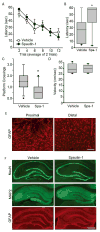A role for autophagy in long-term spatial memory formation in male rodents
- PMID: 29230855
- PMCID: PMC6425965
- DOI: 10.1002/jnr.24121
A role for autophagy in long-term spatial memory formation in male rodents
Abstract
A hallmark of long-term memory formation is the requirement for protein synthesis. Administration of protein synthesis inhibitors impairs long-term memory formation without influencing short-term memory. Rapamycin is a specific inhibitor of target of rapamycin complex 1 (TORC1) that has been shown to block protein synthesis and impair long-term memory. In addition to regulating protein synthesis, TORC1 also phosphorylates Unc-51-like autophagy activating kinase-1 (Ulk-1) to suppress autophagy. As autophagy can be activated by rapamycin (and rapamycin inhibits long-term memory), our aim was to test the hypothesis that autophagy inhibitors would enhance long-term memory. To examine if learning alters autophagosome number, we used male reporter mice carrying the GFP-LC3 transgene. Using these mice, we observed that training in the Morris water maze task increases the number of autophagosomes, a finding contrary to our expectations. For learning and memory studies, male Long Evans rats were used due to their relatively larger size (compared to mice), making it easier to perform intrahippocampal infusions in awake, moving animals. When the autophagy inhibitors 3-methyladenine (3-MA) or Spautin-1 were administered bilaterally into the hippocampii prior to training in the Morris water maze task, the drugs did not alter learning. In contrast, when memory was tested 24 hours later by a probe trial, significant impairments were observed. In addition, intrahippocampal infusion of an autophagy activator peptide (TAT-Beclin-1) improved long-term memory. These results indicate that autophagy is not necessary for learning, but is required for long-term memory formation.
Keywords: autophagy; hippocampus; long-term memory; water maze.
© 2017 Wiley Periodicals, Inc.
Conflict of interest statement
Figures





Similar articles
-
The histone H3 lysine 9 methyltransferase G9a/GLP complex activity is required for long-term consolidation of spatial memory in mice.Neurobiol Learn Mem. 2021 Mar;179:107406. doi: 10.1016/j.nlm.2021.107406. Epub 2021 Feb 17. Neurobiol Learn Mem. 2021. PMID: 33609736
-
Autophagy coupled to translation is required for long-term memory.Autophagy. 2021 Jul;17(7):1614-1635. doi: 10.1080/15548627.2020.1775393. Epub 2020 Jun 17. Autophagy. 2021. PMID: 32501746 Free PMC article.
-
Reduction of autophagy markers mediated protective effects of JNK inhibitor and bucladesine on memory deficit induced by Aβ in rats.Naunyn Schmiedebergs Arch Pharmacol. 2016 May;389(5):501-10. doi: 10.1007/s00210-016-1222-x. Epub 2016 Feb 22. Naunyn Schmiedebergs Arch Pharmacol. 2016. PMID: 26899864
-
Electroacupuncture improves memory and protects neurons by regulation of the autophagy pathway in a rat model of Alzheimer's disease.Acupunct Med. 2016 Dec;34(6):449-456. doi: 10.1136/acupmed-2015-010894. Epub 2016 Feb 19. Acupunct Med. 2016. PMID: 26895770
-
Dorsal hippocampus not always necessary in a radial arm maze delayed win-shift task.Hippocampus. 2020 Feb;30(2):121-129. doi: 10.1002/hipo.23141. Epub 2019 Aug 27. Hippocampus. 2020. PMID: 31453652
Cited by
-
Spermidine protects from age-related synaptic alterations at hippocampal mossy fiber-CA3 synapses.Sci Rep. 2019 Dec 23;9(1):19616. doi: 10.1038/s41598-019-56133-3. Sci Rep. 2019. PMID: 31873156 Free PMC article.
-
The effect of cordycepin on brain oxidative stress and protein expression in streptozotocin-induced diabetic mice.J Vet Med Sci. 2021 Sep 15;83(9):1425-1434. doi: 10.1292/jvms.21-0268. Epub 2021 Jul 31. J Vet Med Sci. 2021. PMID: 34334512 Free PMC article.
-
Critical roles of nicotinic acetylcholine receptors in olfactory memory formation and retrieval in crickets.Front Physiol. 2024 Feb 9;15:1345397. doi: 10.3389/fphys.2024.1345397. eCollection 2024. Front Physiol. 2024. PMID: 38405118 Free PMC article.
-
Neural ageing and synaptic plasticity: prioritizing brain health in healthy longevity.Front Aging Neurosci. 2024 Aug 5;16:1428244. doi: 10.3389/fnagi.2024.1428244. eCollection 2024. Front Aging Neurosci. 2024. PMID: 39161341 Free PMC article. Review.
-
Mechanisms by which autophagy regulates memory capacity in ageing.Aging Cell. 2020 Sep;19(9):e13189. doi: 10.1111/acel.13189. Epub 2020 Jul 30. Aging Cell. 2020. PMID: 32729663 Free PMC article.
References
-
- Abel T, Klann E. Molecular and cellular cognition: Neurobiology of Learning and Memory Special Issue 2013. Neurobiol Learn Mem. 2013;105:1–2. - PubMed
-
- Alberini CM. Genes to remember. J Exp Biol. 1999;202(Pt 21):2887–2891. - PubMed
-
- Atkins CM, Selcher JC, Petraitis JJ, Trzaskos JM, Sweatt JD. The MAPK cascade is required for mammalian associative learning. Nat Neurosci. 1998;1:602–609. - PubMed
Publication types
MeSH terms
Substances
Grants and funding
LinkOut - more resources
Full Text Sources
Other Literature Sources
Molecular Biology Databases
Research Materials

